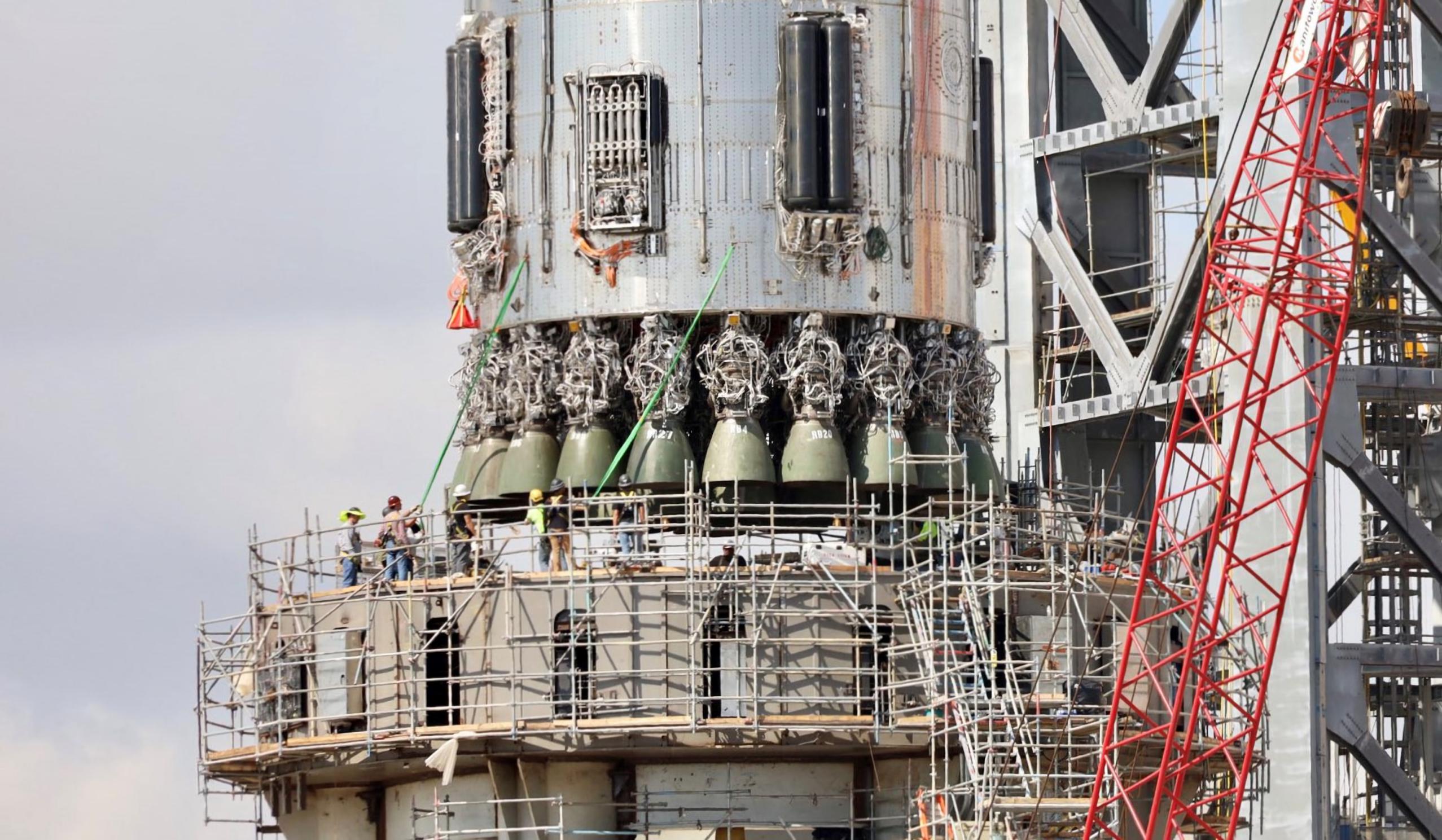

News
Elon Musk says SpaceX could fire up first orbital-class Super Heavy booster next week
Update: In response to this article, SpaceX CEO Elon Musk says that the plan is to not only ‘cryoproof’ the first flightworthy Super Heavy – but to static fire the booster and shake down Starship’s brand new orbital launch complex as early as “next week.”
A lot of work would need to be finished – and all of it smoothly – for an orbital launch pad cryoproof and static fire to be possible just a week or less from now but Musk’s response nevertheless provides invaluable context for SpaceX’s near-term plans and confirms that Super Heavy Booster 4 is ready for integrated testing as-is. Further, Musk’s tweet implies – as speculated – that Starbase’s orbital launch complex tank farm is much closer to test-readiness than it might otherwise appear.
For the second time in five weeks, SpaceX has installed a Super Heavy booster – fitted with 29 Raptor engines – on Starship’s nascent ‘orbital launch mount.’
Both Super Heavy Booster 4 (B4) and the launch mount have undergone substantial changes since they last parted ways four weeks ago. SpaceX teams have been laser-focused on installing the vast array of plumbing, wiring, and components required to turn the hulking steel structures into functional launch facilities and the largest flightworthy rocket and both certainly look the part.
Superheavy Booster 4 pic.twitter.com/jQ7RAN1nCK— SPadre (@SpacePadreIsle) September 8, 2021
Unlike Starship, which has an expansive skirt section perfect for stowing away sensitive plumbing and avionics, Super Heavy has an unusually short interstage and no real skirt, meaning that all the extra hardware SpaceX has installed over the last month or so is impossible to hide. Indeed, when Booster 4 rolled out of Starbase’s high bay for the second time on September 8th, the rocket was blanketed by dozens of new valves, thousands of feet of wiring and plumbing, pressure vessels, multiple hydraulic racks, a ‘quick disconnect’ (QD) umbilical panel for interfacing with the launch pad, places for “flight termination system” (FTS) explosive charges to be installed, and much, much more.
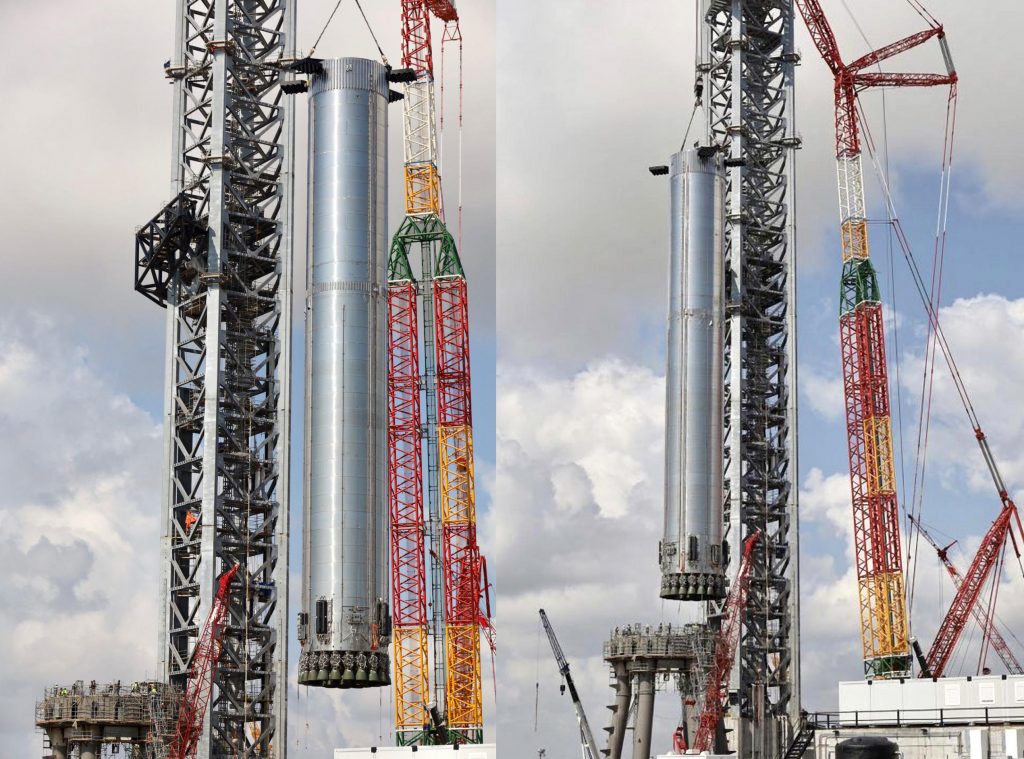
Additionally, Super Heavy B4’s second batch of 29 Raptors – installed in late August – also appear to all have outward-facing umbilical panels that will all the booster to receive some level of assistance from ground systems while igniting those engines. It’s unclear what exactly they’ll do but it’s likely that those engine umbilical will connect to high-pressure gas systems on the ground, presumably minimizing the already absurd amount of COPVs and secondary plumbing present on Super Heavy.
However, Super Heavy will still need to be able to reignite anywhere from 1 to 13 of its 29-32 Raptor engines in flight for boostback and landing burns, potentially explaining the eight large pressure vessels and 100+ small, high-pressure gas lines installed on B4’s aft end. Super Heavy also needs to be able to chill, feed, and purge all 29-32 of its Raptor engines, guaranteeing that Starship’s booster plumbing situation was going to be immensely complex no matter the approach SpaceX took.
In addition to Super Heavy B4’s newfound complexity, SpaceX also spent the last four or so weeks outfitting Starbase’s orbital launch mount’ with all the plumbing, power, avionics, and mechanical systems it will need to function as “Stage Zero” of orbital-class, two-stage Starship rockets. SpaceX has installed most of the secondary quick disconnect structures that will connect to and feed each of Super Heavy’s 20 outer Raptor engines. The main Super Heavy quick disconnect device was also installed and a team has been gradually outfitting and connecting the structure to the plumbing, avionics, and power it will provide boosters.
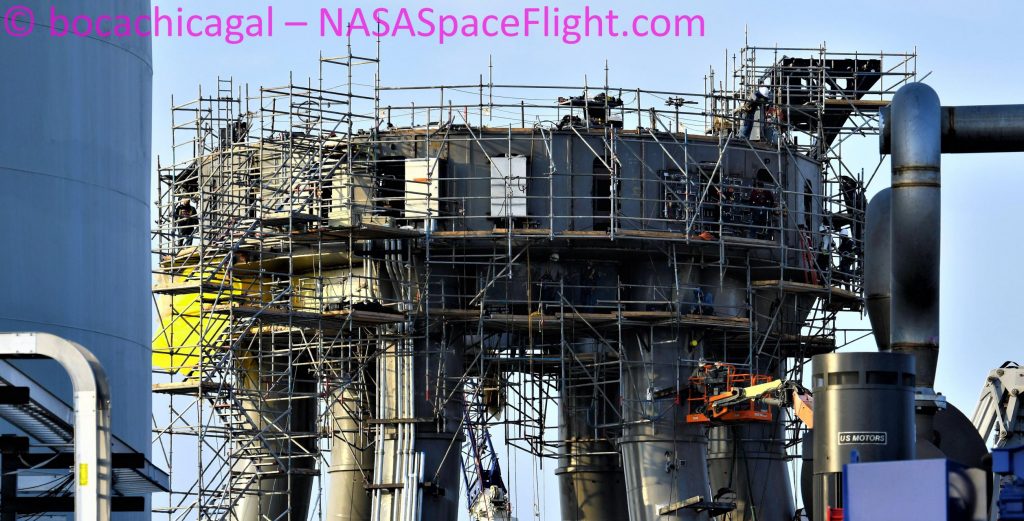
A significant amount of work still remains to connect the orbital launch mount to SpaceX’s incomplete and custom-built orbital tank farm, which will store, supercool, and feed the pad, Super Heavy, and Starship with several thousand metric tons of liquid and gaseous oxygen and methane. It’s difficult to say how close Starbase’s tank farm is to being able to support Starship or Super Heavy testing, which makes it equally unclear what SpaceX’s near-term plans are for Booster 4. It’s possible that the rocket has been reinstalled on the orbital launch mount as a second fit check, perhaps focused on those 20 outer Raptor quick-disconnect mechanisms.
It’s also possible that the tank farm and launch mount plumbing are much closer to completion than expected, meaning that Super Heavy B4 could remain at the orbital pad until it’s completed several crucial cryogenic proof and static fire tests. Of course, short of confirmation from Musk himself, we’ll just have to wait and see.
Elon Musk
Tesla surges following better-than-expected delivery report
Tesla saw some positive momentum during trading hours as it reported its deliveries for Q2.

Tesla (NASDAQ: TSLA) surged over four percent on Wednesday morning after the company reported better-than-expected deliveries. It was nearly right on consensus estimations, as Wall Street predicted the company would deliver 385,000 cars in Q2.
Tesla reported that it delivered 384,122 vehicles in Q2. Many, including those inside the Tesla community, were anticipating deliveries in the 340,000 to 360,000 range, while Wall Street seemed to get it just right.
Tesla delivers 384,000 vehicles in Q2 2025, deploys 9.6 GWh in energy storage
Despite Tesla meeting consensus estimations, there were real concerns about what the company would report for Q2.
There were reportedly brief pauses in production at Gigafactory Texas during the quarter and the ramp of the new Model Y configuration across the globe were expected to provide headwinds for the EV maker during the quarter.
At noon on the East Coast, Tesla shares were up about 4.5 percent.
It is expected that Tesla will likely equal the number of deliveries it completed in both of the past two years.
It has hovered at the 1.8 million mark since 2023, and it seems it is right on pace to match that once again. Early last year, Tesla said that annual growth would be “notably lower” than expected due to its development of a new vehicle platform, which will enable more affordable models to be offered to the public.
These cars are expected to be unveiled at some point this year, as Tesla said they were “on track” to be produced in the first half of the year. Tesla has yet to unveil these vehicle designs to the public.
Dan Ives of Wedbush said in a note to investors this morning that the company’s rebound in China in June reflects good things to come, especially given the Model Y and its ramp across the world.
He also said that Musk’s commitment to the company and return from politics played a major role in the company’s performance in Q2:
“If Musk continues to lead and remain in the driver’s seat, we believe Tesla is on a path to an accelerated growth path over the coming years with deliveries expected to ramp in the back-half of 2025 following the Model Y refresh cycle.”
Ives maintained his $500 price target and the ‘Outperform’ rating he held on the stock:
“Tesla’s future is in many ways the brightest it’s ever been in our view given autonomous, FSD, robotics, and many other technology innovations now on the horizon with 90% of the valuation being driven by autonomous and robotics over the coming years but Musk needs to focus on driving Tesla and not putting his political views first. We maintain our OUTPERFORM and $500 PT.”
Moving forward, investors will look to see some gradual growth over the next few quarters. At worst, Tesla should look to match 2023 and 2024 full-year delivery figures, which could be beaten if the automaker can offer those affordable models by the end of the year.
Investor's Corner
Tesla delivers 384,000 vehicles in Q2 2025, deploys 9.6 GWh in energy storage
The quarter’s 9.6 GWh energy storage deployment marks one of Tesla’s highest to date.
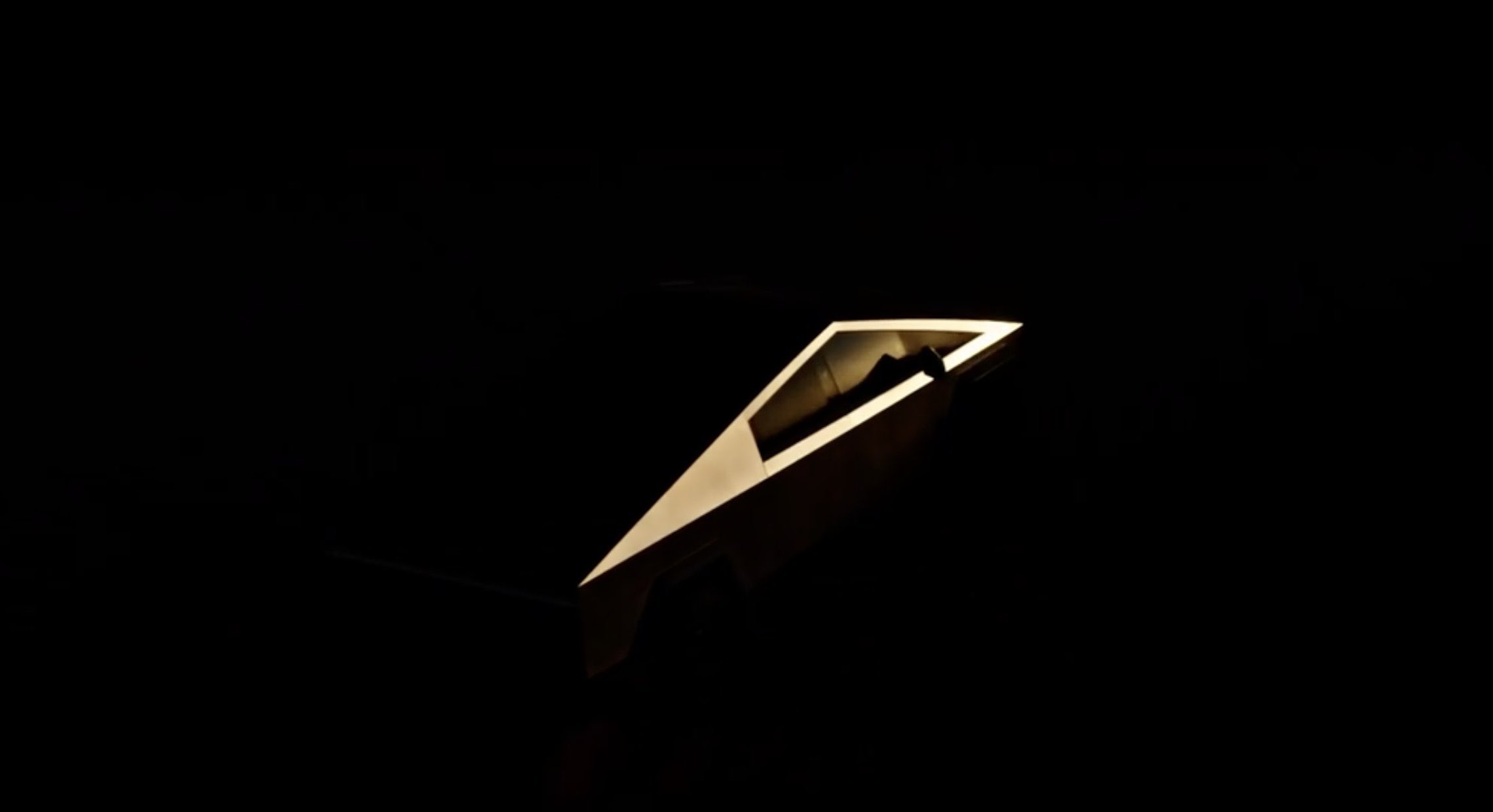
Tesla (NASDAQ: TSLA) has released its Q2 2025 vehicle delivery and production report. As per the report, the company delivered over 384,000 vehicles in the second quarter of 2025, while deploying 9.6 GWh in energy storage. Vehicle production also reached 410,244 units for the quarter.
Model 3/Y dominates output, ahead of earnings call
Of the 410,244 vehicles produced during the quarter, 396,835 were Model 3 and Model Y units, while 13,409 were attributed to Tesla’s other models, which includes the Cybertruck and Model S/X variants. Deliveries followed a similar pattern, with 373,728 Model 3/Ys delivered and 10,394 from other models, totaling 384,122.
The quarter’s 9.6 GWh energy storage deployment marks one of Tesla’s highest to date, signaling continued strength in the Megapack and Powerwall segments.

Year-on-year deliveries edge down, but energy shows resilience
Tesla will share its full Q2 2025 earnings results after the market closes on Wednesday, July 23, 2025, with a live earnings call scheduled for 4:30 p.m. CT / 5:30 p.m. ET. The company will publish its quarterly update at ir.tesla.com, followed by a Q&A webcast featuring company leadership. Executives such as CEO Elon Musk are expected to be in attendance.
Tesla investors are expected to inquire about several of the company’s ongoing projects in the upcoming Q2 2025 earnings call. Expected topics include the new Model Y ramp across the United States, China, and Germany, as well as the ramp of FSD in territories outside the US and China. Questions about the company’s Robotaxi business, as well as the long-referenced but yet to be announced affordable models are also expected.
News
Tesla China breaks 8-month slump by selling 71,599 vehicles wholesale in June
Tesla China’s June numbers were released by the China Passenger Car Association (CPCA) on Tuesday.
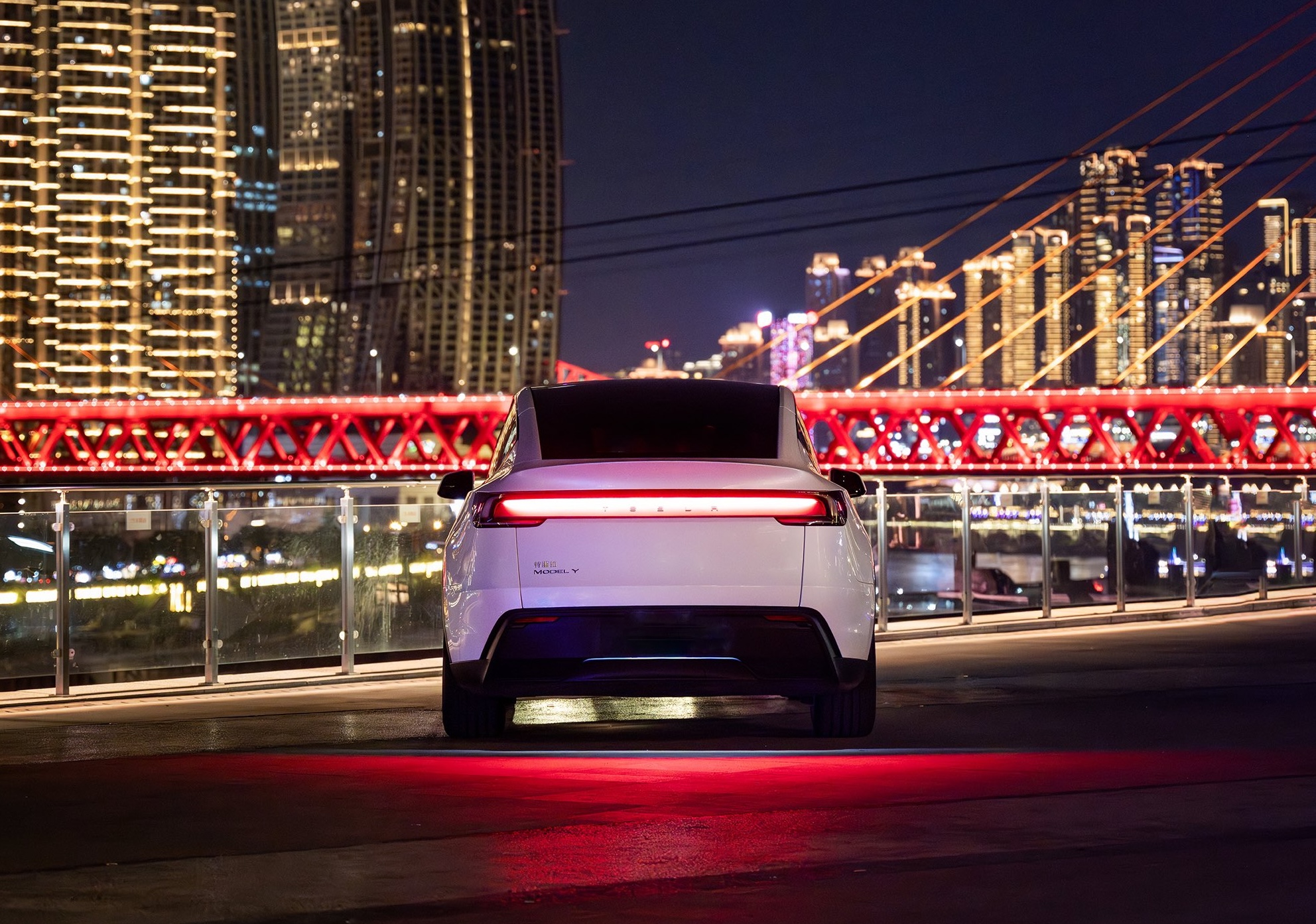
Tesla China was able to sell 71,599 vehicles wholesale in June 2025, reversing eight consecutive months of year-over-year declines. The figure marks a 0.83% increase from the 71,599 vehicles sold wholesale in June 2024 and a 16.1% jump compared to the 61,662 vehicles sold wholesale in May.
Tesla China’s June numbers were released by the China Passenger Car Association (CPCA) on Tuesday.
Tesla China’s June results in focus
Tesla produces both the Model 3 and Model Y at its Shanghai Gigafactory, which serves as the company’s primary vehicle export hub. Earlier this year, Tesla initiated a changeover for its best-selling vehicle, the Model Y, resulting in a drop in vehicle sales during the first and second quarters.
Tesla’s second-quarter China sales totaled 191,720 units including exports. While these numbers represent a 6.8% year-over-year decline for Tesla China, Q2 did show sequential improvement, rising about 11% from Q1 2025, as noted in a CNEV Post report.
For the first half of the year, Tesla sold 364,474 vehicles wholesale. This represents a 14.6% drop compared to the 426,623 units sold wholesale in the first half of 2024.
China’s competitive local EV market
Tesla’s position in China is notable, especially as the new Model Y is gaining ground in the country’s BEV segment. That being said, Tesla is also facing competition from impressive local brands such as Xiaomi, whose new YU7 electric SUV is larger and more affordable than the Model Y.
The momentum of the YU7 is impressive, as the vehicle was able to secure 200,000 firm orders within three minutes and over 240,000 locked-in orders within 18 hours. Xiaomi’s previous model, the SU7 electric sedan, which is aimed at the Tesla Model 3, also remains popular, with June deliveries surpassing 25,000 units for the ninth straight month.
While China’s EV market is getting more competitive, Tesla’s new Model Y is also ramping its production and deliveries. Needless to say, Tesla China’s results for the remaining two quarters of 2025 will be very interesting.
-

 Elon Musk2 days ago
Elon Musk2 days agoTesla investors will be shocked by Jim Cramer’s latest assessment
-

 News7 days ago
News7 days agoTesla Robotaxi’s biggest challenge seems to be this one thing
-

 News2 weeks ago
News2 weeks agoTesla’s Grok integration will be more realistic with this cool feature
-

 Elon Musk2 weeks ago
Elon Musk2 weeks agoElon Musk slams Bloomberg’s shocking xAI cash burn claims
-

 News2 weeks ago
News2 weeks agoTexas lawmakers urge Tesla to delay Austin robotaxi launch to September
-

 Elon Musk1 week ago
Elon Musk1 week agoFirst Look at Tesla’s Robotaxi App: features, design, and more
-
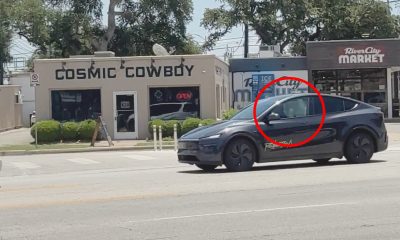
 Elon Musk2 weeks ago
Elon Musk2 weeks agoTesla Robotaxis are becoming a common sight on Austin’s public roads
-
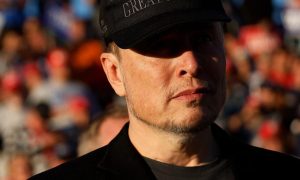
 Elon Musk2 weeks ago
Elon Musk2 weeks agoTesla CEO Elon Musk hits back at drug use claims, calls publications ‘hypocrites’




















